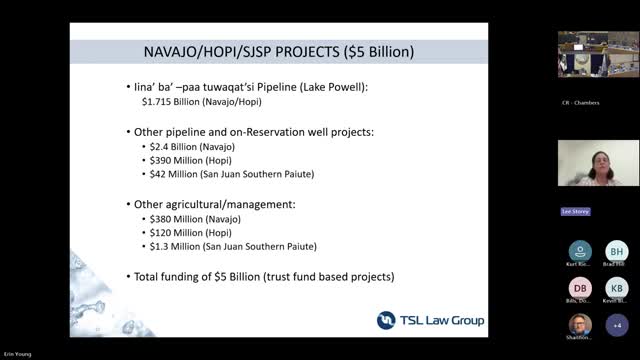Navajo Nation seeks $5 billion for vital water projects
July 25, 2024 | Flagstaff City, Coconino County, Arizona

This article was created by AI summarizing key points discussed. AI makes mistakes, so for full details and context, please refer to the video of the full meeting. Please report any errors so we can fix them. Report an error »

In a recent government meeting, officials discussed a monumental $5 billion water supply initiative aimed at benefiting the Navajo Nation, the Hopi Tribe, and the San Juan Southern Paiute Tribe. This ambitious project, which is currently under consideration in Congress, includes significant infrastructure developments such as the Western Navajo Pipeline, designed to transport water from the Colorado River to various communities, including a crucial spur to the Hopi Tribe at Maungopi.
The funding breakdown reveals that the Navajo Nation will receive approximately $2.4 billion, the Hopi Tribe $390 million, and the San Juan Southern Paiute Tribe $42 million. These funds will support not only pipeline construction but also groundwater pumping projects and agricultural water management initiatives.
The meeting highlighted the pressing need for improved water infrastructure, particularly in light of the high costs associated with water supply projects in the region. Officials noted that the Navajo Nation, being the largest land-based tribe in the U.S., faces unique challenges in extending water services across its vast territory. The proposed projects aim to enhance existing systems, such as the Navajo Gallup Water Supply Project, and to address water quality concerns, especially in areas where groundwater is currently of poor quality.
Key discussions also revolved around the Red Gap Regional Groundwater Project, which is part of a broader water settlement agreement. This project is expected to provide better water quality and supply to the southwestern portion of the Navajo reservation, facilitating access to water for communities that are currently underserved.
The meeting underscored the collaborative efforts between the Navajo Nation, the Hopi Tribe, and state agencies to ensure that the water supply projects meet the needs of the communities involved while navigating the complexities of infrastructure development in the region. As the initiative moves forward, it promises to significantly impact water access and quality for thousands of residents across these tribal lands.
The funding breakdown reveals that the Navajo Nation will receive approximately $2.4 billion, the Hopi Tribe $390 million, and the San Juan Southern Paiute Tribe $42 million. These funds will support not only pipeline construction but also groundwater pumping projects and agricultural water management initiatives.
The meeting highlighted the pressing need for improved water infrastructure, particularly in light of the high costs associated with water supply projects in the region. Officials noted that the Navajo Nation, being the largest land-based tribe in the U.S., faces unique challenges in extending water services across its vast territory. The proposed projects aim to enhance existing systems, such as the Navajo Gallup Water Supply Project, and to address water quality concerns, especially in areas where groundwater is currently of poor quality.
Key discussions also revolved around the Red Gap Regional Groundwater Project, which is part of a broader water settlement agreement. This project is expected to provide better water quality and supply to the southwestern portion of the Navajo reservation, facilitating access to water for communities that are currently underserved.
The meeting underscored the collaborative efforts between the Navajo Nation, the Hopi Tribe, and state agencies to ensure that the water supply projects meet the needs of the communities involved while navigating the complexities of infrastructure development in the region. As the initiative moves forward, it promises to significantly impact water access and quality for thousands of residents across these tribal lands.
View full meeting
This article is based on a recent meeting—watch the full video and explore the complete transcript for deeper insights into the discussion.
View full meeting
